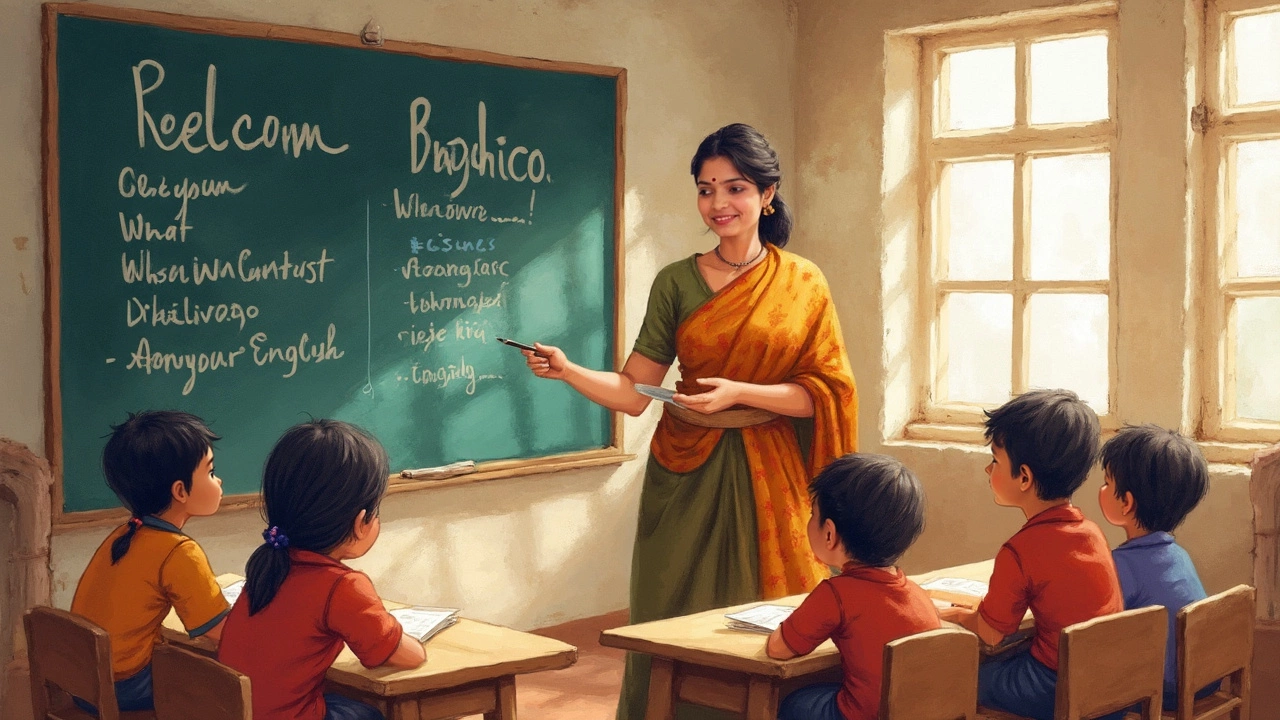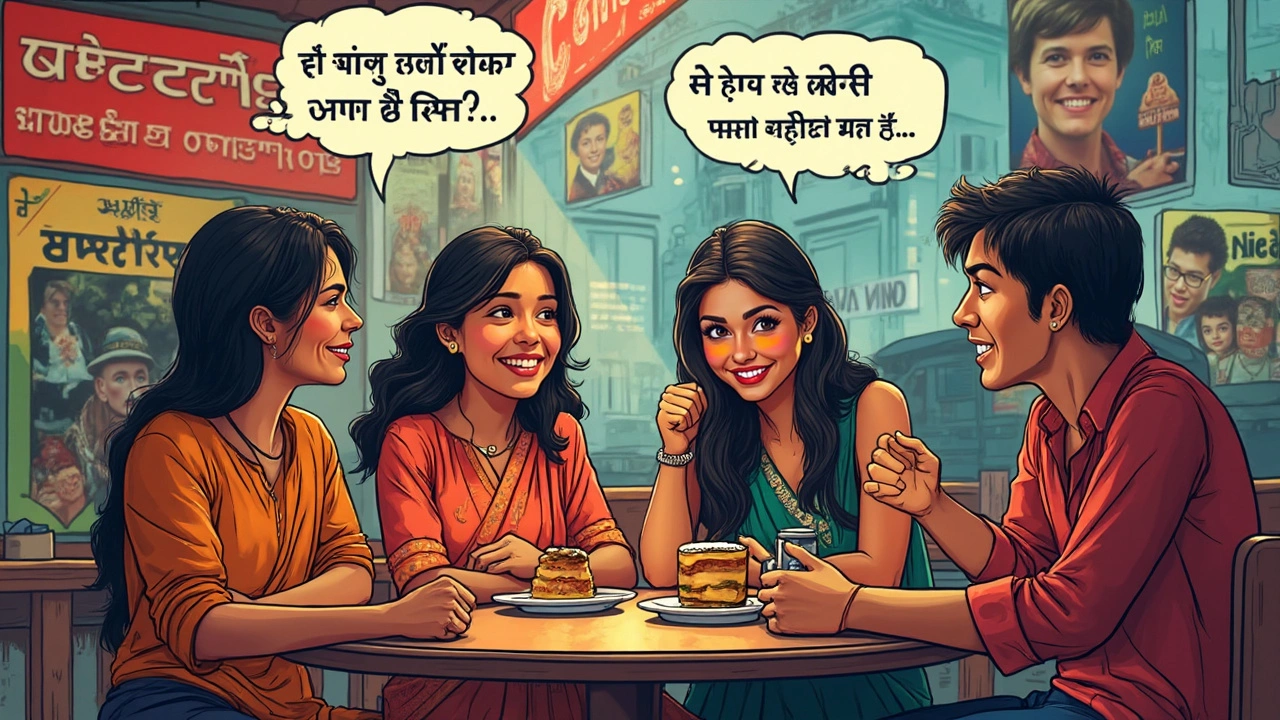English Words in Hindi: Why They're Everywhere and What It Means for English Learners
Walk down any busy street in Delhi or scroll through Indian social media, and you’ll hear Hindi speakers dropping English words left and right. 'Yaar, I’m so tired today' or 'Bhai, meeting hai kal.' Sound familiar? This isn’t just random mixing. There’s a whole story behind why English has muscled its way into daily Hindi conversations — and it’s not just to sound cool.
Turns out, this isn’t a new thing. English started showing up in Hindi way back in colonial times. Over generations, everything from school subjects to movie scripts picked up more English words. So yeah, if you’re wondering why 'train,' 'mobile,' or even 'sorry' come up in the middle of a Hindi sentence, it’s because English is just baked into the way people talk now.
This isn’t just about vocabulary either. Understanding why people do this can actually help you pick up English faster, especially if you’re learning in India. Go to any English course, and you’ll spot students switching from Hindi to English and back again. That’s not a weakness — it's how most people here get better at English every day.
- How English crept into Hindi
- School, movies, and daily life: Where it shows up
- Hinglish: When Hindi and English mix
- Why people love (and sometimes hate) this mashup
- Can Hinglish help you learn English?
- Tips for English learners in India
How English crept into Hindi
If you look at history, the main reason English words in Hindi are everywhere is the time when the British ruled India. English started showing up in schools, government offices, courts, and even train stations. India's first official English school popped up way back in 1817. People realized fast: if you wanted a government job or wanted to keep up in society, you had to know some English.
By the time India became independent in 1947, English had already settled into education, science, and business. Even the Indian Constitution was first written in English. Hindi newsreaders and teachers began using terms like "budget," "committee," and "hospital" because there were no simple Hindi words for these.
Fast forward to the 1990s, India opened up to global markets. International companies set up offices, cable TV brought global content, and suddenly, English wasn’t just official—it was everywhere: movies, ads, even cricket commentary. Urban youngsters picked up words like 'deadline' or 'status' without even thinking.
- Many Indian schools (especially in cities) offer English as the main language of instruction.
- Common official things like railways, traffic signs, and bank forms use English alongside Hindi.
- Hollywood and Bollywood both mix Hinglish into scripts, making it normal to switch languages mid-sentence.
Here’s how much this has changed things:
| Year | Major English Influence Events |
|---|---|
| 1817 | First English medium school in India |
| 1858 | English becomes main administrative language |
| 1947 | English used in Parliament, law, education |
| 1991 | Economic liberalisation, rise of English TV & jobs |
This mix wasn’t forced—people just saw the value. If you grew up in India and wanted access to good jobs, cool TV shows, or even just official paperwork, some English was non-negotiable. That’s why you’ll find Indian English words in Hindi conversations pretty much everywhere today.
School, movies, and daily life: Where it shows up
Start with any classroom in India, and you’ll catch students and teachers slipping English words in Hindi between every other line. English isn’t just another subject; most school boards, especially CBSE and ICSE, teach math, science, and even history in English. So, when kids discuss homework, they’ll say, 'Kal exam hai,' or, 'Homework submit karna hai,' because the terms just don’t have short, natural Hindi alternatives.
Now think about Bollywood. If you turn on a hit film made in the last decade, chances are you’ll hear lines like 'Party shuru karte hain!' or 'Tumhara attitude problem hai.' Film scripts are loaded with Hinglish—which means mixing English words in Hindi sentences. Directors know people relate better when they see their real way of talking on screen.
This mashup pops up even more in daily life. Shopkeepers use 'discount,' people book a 'cab' instead of a 'taxi,' and friends plan to 'chill' after work. On social media, memes often only make sense if you know both Hindi and English—making this blend a part of young people’s identity.
Here’s a quick look at where you’ll spot this language mixing the most:
- Schools & colleges: Teachers explaining, students answering, all with a spicy mix.
- Workplaces: Office talk is full of phrases like 'report banana hai' or 'client call aaya hai.'
- Movies/TV: Hinglish dialogues are now a brand in themselves.
- Advertisements: Slogans like 'Eat healthy, stay fit' air in Hindi commercials without any translation.
- Social media: Memes, posts, and hashtags are a real playground for English words in Hindi.
A 2023 survey by the British Council found that over 70% of urban Indians regularly use English words in Hindi at work or school. It’s all about being understood fast and sounding relatable. So next time you hear 'presentation banana hai' or 'budget tight hai,' you’re just hearing modern India in action.
Hinglish: When Hindi and English mix
If you’ve ever heard your friends say something like, "Mujhe ek coffee chahiye, please," you’ve seen Hinglish in action. It’s not just street talk; it’s everywhere — ads, movies, memes, and even news anchors slip from Hindi to English and back without missing a beat. This kind of language mixing is called ‘code-switching’, but most people just call it Hinglish.
Here’s the deal: English words in Hindi aren’t random. They usually show up because they’re quicker, more trendy, or there just isn’t a clear Hindi word for stuff like “video call” or “laptop.” Over time, certain English words pretty much replaced their Hindi cousins, especially when people talk about tech, business, or school.
Think this is rare? Nope. Check out this stat:
| Context | English Words per 100 Hindi Words |
|---|---|
| Movies | 20-30 |
| Social Media Posts | 30-40 |
| Casual Speech (Friends) | 15-25 |
It’s not just about convenience. Using a mix of languages can show off your personality or make things feel more relatable. You’ll even find books written partly in Hinglish. Try reading "Chetan Bhagat" or watching shows like “The Family Man.” You’ll notice how natural code-switching sounds these days.
Why do people love it so much? For a lot of young folks, it’s just how you fit in. Hinglish signals you’re up-to-date and understand both local and global vibes. Some people even say that texting or talking in Hinglish makes communication faster. And with Indian English making its way into global brands and pop culture, Hinglish is only becoming more common.
So don’t be surprised when someone says, "Chalo, movie plan karte hain," instead of a pure Hindi sentence. It just feels easier, and for most folks, that’s what matters.

Why people love (and sometimes hate) this mashup
So, why do so many folks in India get hooked on mixing Hindi and English, or what everyone now calls Hinglish? For a lot of people, it just feels natural. It lets them pull in the best of both languages—one line can sound fresh, modern, and still familiar. There’s also a sense of belonging when your friends all talk this way. Try saying, "Chalo, let's go for chai," and you instantly fit into a local group in almost any big city.
Mixing English words in Hindi isn’t just about style. It solves real-world problems. Think about tech gadgets, office terms, or pop culture—there are often no direct Hindi words for them. So instead of inventing clunky translations, people just use what works. Even news anchors and politicians do this on national TV. Ever heard an ad say, "Best deals available now" right in the middle of a Hindi sentence? That’s exactly it.
But, of course, not everyone is a fan. Some worry that too much Hinglish is making people forget proper Hindi. A survey in 2023 found that about 30% of people over 40 said they wish younger folks would use more pure Hindi in daily life. Others argue it makes communicating with elders or people from rural areas harder—especially when words like 'network', 'party', or 'update' start popping up everywhere.
Here’s a quick look at what draws people in—and what turns them off:
- Why people love it: Feels modern and trendy, easier to express new ideas, helps connect with young crowds, fits perfectly in digital chats and memes.
- Why some people hate it: Worry about losing traditional Hindi, makes some conversations confusing for older or rural speakers, sometimes people use it just to show off.
Interestingly, schools have started accepting Hinglish in casual contexts, but most stick to classic English for exams and teaching. So the mashup might be here to stay, but knowing when and where to use it is still a balancing act.
| Group | Feels Positive | Feels Negative |
|---|---|---|
| Teens & Students | 62% | 14% |
| Urban Professionals | 58% | 22% |
| Over 40 (Urban/Rural) | 28% | 35% |
This mix of love and hate just shows how English words in Hindi touch almost everyone’s life in India, no matter which side you're on.
Can Hinglish help you learn English?
This is the big question—does using Hinglish actually make it easier to pick up English learning in India? For most people, the answer is yes, but there are a few things you need to know.
First, slipping English words into Hindi conversation is like a shortcut. If you already say 'weekend' or 'plan' in every chat, those words become second nature. According to a 2023 Cambridge University study, Indian students who used 'code-switching'—that is, flipping between Hindi and English—showed 20% better recall of English vocabulary in everyday situations than those who stuck to only one language.
But it’s not perfect. You might learn words, but proper structure and pronunciation often get left behind. Sometimes, you’ll pick up words like 'timepass' or 'prepone'—terms that feel totally normal in India but make zero sense in a British or American classroom. That’s the funny thing about Indian English—it follows rules you won’t find anywhere else.
“Hinglish is the bridge for millions of Indians to cross into fluent English. But at some point, you need to leave the bridge if you want to reach the other side.” — Professor Anita Sharma, English Language Expert, Delhi University
So, if you want to use Hinglish for your English boost, here are some tips:
- Use English words in your Hindi chats, but also practice full sentences in English when possible.
- Read Indian English newspapers like Times of India—they use loads of English words but in an Indian style, so it feels close to Hinglish but more formal.
- Watch Indian movies or YouTube channels where people switch between languages—try repeating their lines out loud.
- Don’t get stuck with just the borrowed words—learn common grammar fixes and correct accent.
Bottom line: Mixing English and Hindi makes learning English less scary and way more practical. Just remember, if you want to sound natural in global English settings, practice switching off the Hinglish sometimes. It’s good to be comfortable in both worlds.
Tips for English learners in India
If you’re learning English in India, you’re definitely not alone. Over 350 million Indians use English in some way, making India second only to the US for English speakers. But mixing it with Hindi—or using Hinglish—can be both a help and a hurdle, depending on how you play it.
- Don’t worry if you mix Hindi and English. Nearly everyone does it, especially at the start. But if your goal is to speak pure or more global English, try to notice which English words you lean on and which Hindi words slip in. Being aware can make a big difference.
- Watch Indian English news channels or YouTube creators. NDTV, The Quint, and even comedy creators like Zakir Khan use a lot of English words in Hindi. Listen to how sentences are built, then try copying a few lines. Mimicking real speech helps nail down grammar and pronunciation without sounding robotic.
- Take an English course in India—especially one with real conversation practice. Studies from the British Council show that classes with more speaking and less grammar cramming help people remember words better and use them more naturally.
- Don’t just read textbooks. Pick up popular magazines, memes, or even Bollywood scripts. They’re full of Indian English phrases you’ll actually hear in real life, instead of just stiff, formal language.
- Find a speaking buddy. Loads of language exchange apps match you with people who want to swap Hindi for English chats. Talking is where you’ll spot your own code-switching habits and get comfortable with new words.
- Make a cheat sheet of tricky words. Everyone has at least ten words (like "opposite," "actual," or "current") that mean one thing in Hinglish but another in global English. Write these down so you don’t get tripped up.
Here’s a quick look at where English learning kicks off for most people in India:
| Age Group | Common English Learning Start |
|---|---|
| 5-6 years old | School (basic ABCs, numbers, colors) |
| 10-12 years old | Middle school (English stories, writing) |
| 16-20 years old | College and job prep (presentations, interviews) |
The key with learning English in India is to stay chill about mixing things up at first, use content you actually enjoy, and talk as much as possible. The more you practice, the easier it gets to nudge out the Hindi words when you really need to—and know when it’s okay to let them stay.





